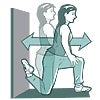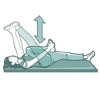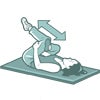Winter Camping: Navigation
Learn to figure out where you are (even in a whiteout) and prevent, or stop, a snowy fall.
Find Your Way | Follow a Bearing in a Whiteout | Prevent/Stop a Snowy Fall
FIND YOUR WAY
Where am I?
3 simple tips for sure-footed winter navigation
Snow often obscures signs, cairns, and other landmarks. BACKPACKER map editor Kris Wagner says GPS–and strong map skills–are essential for extensive winter travel. He offers these guidelines for keeping on track.
1. Check your math. New winter hikers almost always overestimate the distance they’ve covered–and wonder why the map doesn’t match where they think they are. Consult your topo more frequently, and expect to travel half the distance you normally do in summer.
2. Don’t be blindsided. Trails often vanish in deep snow or unexpected whiteouts. Know how to take and follow a compass bearing by reading the terrain on your map. As a backup, upload pre-plotted coordinates of your route onto your GPS. Visit backpacker.com/hikes for thousands of GPS-enabled hikes.
3. Know steep snow. Learn how to read snow conditions and calculate slope angle using a topo map. Enroll in an avalanche class and carry the Brooks-Range Winter Traveler Toolkit ($53; brooks-range.com), a series of waterproof cheat sheets that aid in snow safety and navigation.
Find Your Way | Follow a Bearing in a Whiteout | Prevent/Stop a Snowy Fall
HOW TO: Follow a Bearing in a Whiteout

Let’s say your destination lies due east; your compass reads 90 degrees. You’ve been using a peak that also lies due east as a navigational aid by heading toward it. But what happens when a wall of gusting flakes blows in, obscuring your summit? Here’s how to stick to your route in the worst weather.
1) Pick intermediate landmarks. Take a compass bearing at 90 degrees and choose a smaller feature, such as a boulder or tree, that also lies along that line. Travel to that feature by the easiest route, then shoot another bearing, pick another feature, and repeat until you reach your destination.
2) Sight on your partner. In open, featureless terrain, or if thick snow limits visibility so much that you can’t see intermediate landmarks, set your compass to 90 degrees. Send your partner ahead as far as you can see, waving him left or right to keep him on course. Hike up to join him by the easiest route and repeat.
Find a snow-covered trail Look for blazes, a path-shaped depression in the snow, or an open corridor through the trees.
Find Your Way | Follow a Bearing in a Whiteout | Prevent/Stop a Snowy Fall
PREVENT (AND STOP) A SNOWY FALL
Your ice axe is a ticket to vertical adventure and more interesting backcountry landscapes. Learn how to use it.
Steep, snow-filled couloirs are no place to lose your footing–not when a fall could send you hurtling toward cliffs or talus piles at high speed. Before venturing out, master the art of self-belay (to prevent) and self-arrest (to stop) a snowy slide.
Self-belay
Hold the axe head in your uphill hand (adze forward) and use it as a third leg, planting the spike into the slope after every two steps. Make sure two points (both feet, or one foot and the axe) are secure before moving the third point. Sink the shaft straight down into the snow, deep enough to hold your weight if you fall: Icy slopes may require several thrusts of the axe to sink it sufficiently. If your feet slip, grab the shaft at snow level with your free hand, weighting the buried portion rather than the part remaining above the snow. Kick your toes into the slope to regain purchase and, gripping the axe as an anchor, slowly stand up.

Self-arrest
If you’re not already sliding on your stomach, you’ll want to get that way. But first, position the axe diagonally across your chest, gripping the shaft with your free hand and holding the head with your other hand, near your shoulder; roll in the direction of the pick (not toward the spike) to flip onto your belly. Throw all of your weight onto the axe pick, gouging it into the slope while kicking your toes into the snow.

